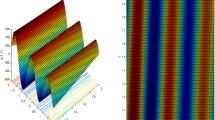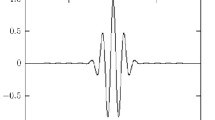Abstract
In this work, we have derived a new \((2+1)\)-dimensional Schrödinger equation that contains separated real and imaginary parts of the dependent variable as follows
This nonintegrable equation has been extracted by adopting the recursion operator of the known Schrödinger equation. However, the resulting model has proven too complex to solve or explore the physical meaning of its solutions. Therefore, we have transferred it into a system of three equations, and then, we have applied the Lie symmetry technique to reduce the latter to a simpler equivalent system. As a result, many solitary wave solutions have been attained, including bright solitary wave, dipole, kink, breather, periodic, and their interactions.






Similar content being viewed by others
Data availability
Data sharing is not applicable to this article as no datasets were generated or analyzed during the current study.
References
Ablowitz, M.J., Prinari, B., Trubatch, A.D.: Discrete and Continuous Nonlinear Schrödinger Systems. Cambridge University Press, Cambridge (2003). https://doi.org/10.1017/cbo9780511546709
Akhmediev, N., Ankiewicz, A.: First-order exact solutions of the nonlinear Schrödinger equation in the normal-dispersion regime. Phys. Rev. A 47(4), 3213–3221 (1993). https://doi.org/10.1103/PhysRevA.47.3213
Benoudina, N., Zhang, Y., Khalique, C.M.: Lie symmetry analysis, optimal system, new solitary wave solutions and conservation laws of the Pavlov equation. Commun. Nonlinear Sci. Numer. Simul. 94, 105560 (2021). https://doi.org/10.1016/j.cnsns.2020.105560
Benoudina, N., Zhang, Y., Khalique, C.M., Bessaad, N.: Novel hybrid solitary waves and shrunken-period solutions, solitary Moiré pattern and conserved vectors of the (4 + 1)-Fokas equation Nardjess. Int. J. Geom. Methods Mod. Phys. (2022). https://doi.org/10.1142/S021988782250195X
Biswas, A., Triki, H., Zhou, Q., Moshokoa, S.P., Ullah, M.Z., Belic, M.: Cubic-quartic optical solitons in Kerr and power law media. Opt. (Stuttg) 144, 357–362 (2017). https://doi.org/10.1016/j.ijleo.2017.07.008
Hermann, J., Schätzle, Z., Noé, F.: Deep-neural-network solution of the electronic Schrödinger equation. Nat. Chem. 12(10), 891–897 (2020). https://doi.org/10.1038/s41557-020-0544-y
Hu, X., Li, Y., Chen, Y.: A direct algorithm of one-dimensional optimal system for the group invariant solutions. J. Math. Phys. 56(5), 053504 (2015). https://doi.org/10.1063/1.4921229
Hydon, P.: Symmetry Methods for Differential Equations. Cambridge University Press, New York (2000)
Kragh, H.: Equation with the many fathers. The Klein–Gordon equation in 1926. Am. J. Phys. 52(11), 1024–1033 (1984). https://doi.org/10.1119/1.13782
Krasil’ shchik, I.S., Kersten, P.H.M.: Symmetries and Recursion Operators for Classical and Supersymmetric Differential Equations, 1 edn. Springer, Dordrecht (2000). https://doi.org/10.1007/978-94-017-3196-6
Kumar, R., Verma, R.S.: Dynamics of invariant solutions of mKdV-ZK arising in a homogeneous magnetised plasma. Nonlinear Dyn. 108(4), 4081–4092 (2022). https://doi.org/10.1007/s11071-022-07389-4
Kumar, S., Dhiman, S.K., Baleanu, D., Osman, M.S., Wazwaz, A.M.: Lie symmetries, closed-form solutions, and various dynamical profiles of solitons for the variable coefficient (2+1)-dimensional KP equations. Symmetry (Basel) 14(3), 597 (2022). https://doi.org/10.3390/sym14030597
Lenells, J., Fokas, A.S.: On a novel integrable generalization of the nonlinear Schrödinger equation. Nonlinearity 22(1), 11–27 (2009). https://doi.org/10.1088/0951-7715/22/1/002
Lewenstein, M., Ciappina, M.F., Pisanty, E., Rivera-Dean, J., Stammer, P., Lamprou, T., Tzallas, P.: Generation of optical Schrödinger cat states in intense laser-matter interactions. Nat. Phys. 17(10), 1104–1108 (2021). https://doi.org/10.1038/s41567-021-01317-w
Liu, W., Zhang, Y., Luan, Z., Zhou, Q., Mirzazadeh, M., Ekici, M., Biswas, A.: Dromion-like soliton interactions for nonlinear Schrödinger equation with variable coefficients in inhomogeneous optical fibers. Nonlinear Dyn. 96(1), 729–736 (2019). https://doi.org/10.1007/s11071-019-04817-w
Lou, S.: Higher-dimensional integrable models with a common recursion operator. Commun. Theor. Phys. 28(1), 41–50 (1997). https://doi.org/10.1088/0253-6102/28/1/41
Olver, P.: Applications of Lie Groups to Differential Equations. Springer, New York (1993)
Schrödinger, E.: An undulatory theory of the mechanics of atoms and molecules. Phys. Rev. 28(6), 1049–1070 (1926). https://doi.org/10.1103/PhysRev.28.1049
Triki, H., Biswas, A.: Sub pico-second chirped envelope solitons and conservation laws in monomode optical fibers for a new derivative nonlinear Schrödinger’s model. Opt. (Stuttg) 173, 235–241 (2018). https://doi.org/10.1016/j.ijleo.2018.08.026
Wang, G.: A new (3 + 1)-dimensional Schrödinger equation: derivation, soliton solutions and conservation laws. Nonlinear Dyn. 104(2), 1595–1602 (2021). https://doi.org/10.1007/s11071-021-06359-6
Wazwaz, A.M.: Painlevé analysis for a new integrable equation combining the modified Calogero-Bogoyavlenskii-Schiff (MCBS) equation with its negative-order form. Nonlinear Dyn. 91(2), 877–883 (2018). https://doi.org/10.1007/s11071-017-3916-0
Wazwaz, A.M.: New (3 + 1) -dimensional Painlevé integrable fifth-order equation with third-order temporal dispersion. Nonlinear Dyn. 106(1), 891–897 (2021). https://doi.org/10.1007/s11071-021-06872-8
Wazwaz, A.M., Abu Hammad, M., El-Tantawy, S.: Bright and dark optical solitons for (3 + 1)-dimensional hyperbolic nonlinear Schrödinger equation using a variety of distinct schemes. Opt. (Stuttg) 270(September), 170043 (2022). https://doi.org/10.1016/j.ijleo.2022.170043
Wazwaz, A.M., Albalawi, W., El-Tantawy, S.A.: Optical envelope soliton solutions for coupled nonlinear Schrödinger equations applicable to high birefringence fibers. Opt. (Stuttg) 255(February), 168673 (2022). https://doi.org/10.1016/j.ijleo.2022.168673
Wazwaz, A.M., El-Tantawy, S.A.: A new integrable (3+1)-dimensional KdV-like model with its multiple-soliton solutions. Nonlinear Dyn. 83(3), 1529–1534 (2016). https://doi.org/10.1007/s11071-015-2427-0
Zhang, R.F., Li, M.C., Al-Mosharea, E., Zheng, F.C., Bilige, S.: Rogue waves, classical lump solutions and generalized lump solutions for Sawada-Kotera-like equation. Int. J. Mod. Phys. B 36(5), 1–11 (2022). https://doi.org/10.1142/S0217979222500448
Zhang, R.F., Li, M.C., Gan, J.Y., Li, Q., Lan, Z.Z.: Novel trial functions and rogue waves of generalized breaking soliton equation via bilinear neural network method. Chaos Solitons Fractals 154, 111692 (2022). https://doi.org/10.1016/j.chaos.2021.111692
Zhang, R.F., Li, M.C., Yin, H.M.: Rogue wave solutions and the bright and dark solitons of the (3+1)-dimensional Jimbo-Miwa equation. Nonlinear Dyn. 103(1), 1071–1079 (2021). https://doi.org/10.1007/s11071-020-06112-5
Acknowledgements
This work is supported by the National Natural Science Foundation of China (No. 11371326215 and No. 11975145). We thank the reviewers and editor for their recommendations to improve this manuscript.
Author information
Authors and Affiliations
Corresponding author
Ethics declarations
Conflict of interest
The authors declare that they have no conflict of interest.
Ethical approval
Not applicable.
Additional information
Publisher's Note
Springer Nature remains neutral with regard to jurisdictional claims in published maps and institutional affiliations.
Rights and permissions
Springer Nature or its licensor (e.g. a society or other partner) holds exclusive rights to this article under a publishing agreement with the author(s) or other rightsholder(s); author self-archiving of the accepted manuscript version of this article is solely governed by the terms of such publishing agreement and applicable law.
About this article
Cite this article
Benoudina, N., Zhang, Y. & Bessaad, N. A new derivation of (2 + 1)-dimensional Schrödinger equation with separated real and imaginary parts of the dependent variable and its solitary wave solutions. Nonlinear Dyn 111, 6711–6726 (2023). https://doi.org/10.1007/s11071-022-08193-w
Received:
Accepted:
Published:
Issue Date:
DOI: https://doi.org/10.1007/s11071-022-08193-w




